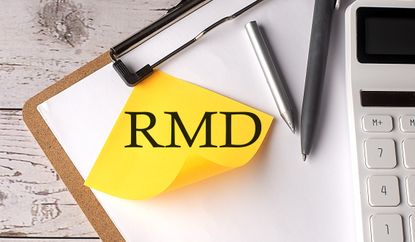Required Minimum Distributions (RMDs): Key Points to Know
Here are some basics to know about required minimum distributions and how RMDs can impact your taxes.


It is important to have a good grasp of required minimum distribution (RMD) rules and the tax implications that come with them. That can help you manage your tax obligations effectively in retirement.
To get started, here is an overview of some core RMD concepts.
Of course, if you need more detailed information, it's best to seek guidance from a qualified financial advisor or tax professional.

Sign up for Kiplinger’s Free E-Newsletters
Profit and prosper with the best of expert advice on investing, taxes, retirement, personal finance and more - straight to your e-mail.
Profit and prosper with the best of expert advice - straight to your e-mail.
Overview
What are required minimum distributions (RMDs)?
A required minimum distribution is money that must be taken out of a retirement savings plan. More specifically, RMDs are the minimum amounts that must come out of given retirement plan accounts each year once the account holder reaches a certain age.
RMDs, calculated based on a formula described below, are generally designed to ensure that retirees gradually draw down their retirement savings and pay taxes on the funds as they withdraw them.
Key points:
- Due to the SECURE 2.0 Act, the RMD age rose from 72 to 73 in 2023 and will rise again to 75 in 2033.
- RMD rules generally apply to employer-sponsored retirement plans such as traditional IRAs, 401(k)s, 403(b)s, and 457(b) plans.
- The IRS says the RMD rules also apply to traditional IRAs and IRA-based plans such as SEPs, SARSEPs, and SIMPLE IRAs.
- Inherited IRAs may be subject to different rules.
RMD Deadlines
RMD Age: When are RMDs due?
According to the IRS, April 1 is a key RMD deadline for some older adults receiving their first required distribution from an IRA, 401(k), or similar retirement plan.
That’s because the first RMD is due by April 1 of the year following the calendar year in which you reach age 73, if you reach 72 after Dec. 31, 2022. Subsequent RMDs generally have to be made by Dec. 31.
If you miss an RMD deadline or fail to pay the minimum amount, you may be subject to an IRS penalty (more on that below).
Note: Taking two RMDs in one year can have important tax implications.
Those distributions could push you into a higher tax bracket, meaning a larger portion of your Social Security income could be subject to taxes. You could also end up paying more for Medicare Part B or Part D premiums.
- For more information, see: Is Your First RMD Due April 1?
- Also see: One Key Rule to Understanding Your 2023 RMD
How to calculate RMDs
Calculating 2024 RMD
RMDs are calculated based on life expectancy tables provided by the IRS and the retirement account's value. To calculate your RMD, you divide the value of each retirement account at the end of the previous year by the IRS distribution period based on your age when you take the RMD.
- The account balance used for the RMD calculation is typically determined by the fair market value of all retirement accounts on Dec. 31st of the previous year.
- The distribution period for RMDs is determined based on the account owner's age and life expectancy, as provided in the IRS tables.
Chris Gullotti, financial advisor and partner at Canby Financial Advisors, provides an example of how this works. “Say your IRA was worth $500,000 at the end of 2023, and you were taking your first RMD at age 73 [that] year. Your distribution amount would be $18,868 ($500,000 divided by 26.5).”
For more information, see Gullotti’s article for Kiplinger: What You Need to Know About Calculating RMDs for 2024.
How RMDs are Taxed
How required minimum distributions are taxed

RMDs are taxed as ordinary income and can push retirees into higher federal income tax brackets, which can increase the overall tax burden. As a result, you should plan distributions strategically to help minimize tax liabilities.
Note: To have an effective tax plan for retirement, it's also important to know how the IRS taxes other types of retirement income.
For example, life insurance proceeds, long-term care insurance payments, disability benefits, muni bond interest, and alimony and child support are generally not taxable. Additionally, earned income in states with no income tax isn't subject to tax at the state level.
Still, your tax planning should consider the tax treatment of income from annuities, pensions, and Social Security benefits. You will also want to assess tax liability from various investments, earnings, and proceeds.
Special RMD rules
Other RMD considerations
Inherited IRAs may have different RMD rules and timelines depending on the beneficiary's relationship to the original account holder.
- Also, Roth IRAs are not subject to RMD requirements during the account owner's lifetime but may be subject to RMDs for some beneficiaries.
- As of 2024, RMDs are not required from designated Roth accounts.
IRS RMD delays: The IRS delayed the final rules governing inherited IRA RMDs — to 2024. As a result, some beneficiaries of inherited IRAs had more time to adapt to distribution requirements. The IRS will waive penalties for RMDs missed in 2023 from IRAs inherited in 2022, where the deceased owner was already subject to RMDs.
With previously granted relief, the IRS waived penalties for missed RMDs from specific IRAs inherited in 2020, 2021, and 2022. For more information on the IRS RMD delays, see Another IRS RMD Delay.
RMD Penalties
Penalty for not taking RMD
Failing to take RMDs on time or in the correct amount can result in substantial IRS tax penalties. RMD penalties are calculated based on the shortfall between the actual distribution taken and the amount that should have been withdrawn.
In the past, those penalties were typically 50% of the required amount not withdrawn. However, under the SECURE 2.0 Act, penalties for not taking RMDs are lower.
- The penalty is a 25% excise tax on the late RMD or RMDs that don’t meet the minimum amount.
- However, if you correct the RMD within a certain period (i.e., by the end of the second year after the RMD was due), the penalty can be as low as 10%.
For more information on these and other RMD rule changes, see Kiplinger’s report on new RMD rules.
Tax filing
Reporting RMDs on your tax return
Financial institutions typically issue Form 1099-R to report distributions from retirement accounts, including RMDs. As mentioned, seeking guidance from qualified and trusted financial and tax advisors when filing your return (or beforehand) can help you develop personalized strategies to manage RMDs effectively.
Minimizing RMD Tax Impacts
RMD strategies

Common strategies some taxpayers use to minimize the tax impact of RMDs include but are not limited to Qualified Charitable Distributions (QCDs), considering Roth conversions, and planning withdrawals to reduce taxable income and stay within lower tax brackets.
Also, consulting with a financial advisor to understand how RMDs affect estate planning can help you make informed decisions about inheritance strategies. Doing so can minimize tax burdens for heirs and beneficiaries.
Related: Is a Roth Conversion for You? Seven Factors to Consider
Required minimum distribution basics: Bottom line
Learning about RMDs is crucial for managing income in retirement. By viewing RMDs as part of an overall retirement income strategy, retirees can ensure a steady income while preserving retirement savings for future needs.
Related

As the senior tax editor at Kiplinger.com, Kelley R. Taylor simplifies federal and state tax information, news, and developments to help empower readers. Kelley has over two decades of experience advising on and covering education, law, finance, and tax as a corporate attorney and business journalist.
-
 What Does Tesla Stock's Latest Slide Mean for Investors?
What Does Tesla Stock's Latest Slide Mean for Investors?Tesla stock is down more than 35% in 2024 and the company just announced layoffs. Here's what you need to know.
By Joey Solitro Published
-
 Why Is UnitedHealth Stock Soaring After Earnings?
Why Is UnitedHealth Stock Soaring After Earnings?UnitedHealth beat expectations for the first quarter, sending UNH stock up over 5%. Here's what you need to know.
By Joey Solitro Published
-
 Retirees Face Significant Tax Bills Due to Fraud
Retirees Face Significant Tax Bills Due to FraudFraud A new report sheds light on how older adult scam victims end up with big tax bills and lost retirement savings.
By Kelley R. Taylor Last updated
-
 Tax Day: Is the Post Office Open Late?
Tax Day: Is the Post Office Open Late?Tax Filing Tax Day means some people need to mail their federal income tax returns.
By Kelley R. Taylor Published
-
 High Earners: Beware of These Illegal Schemes to Lower Taxes
High Earners: Beware of These Illegal Schemes to Lower TaxesTax Schemes The IRS says high-income filers are targets for several illegal tax schemes.
By Katelyn Washington Last updated
-
 Mailing Your Tax Return This Year? What to Know Before You Do
Mailing Your Tax Return This Year? What to Know Before You DoTax Filing There are plenty of reasons not to mail your tax return this year, but here’s what you should know if you are.
By Katelyn Washington Last updated
-
 IRS Warning: Beware of Smishing and 'Helper' Tax Scams
IRS Warning: Beware of Smishing and 'Helper' Tax ScamsScams Tax season is a time to look out for email and text message scams.
By Kelley R. Taylor Last updated
-
 Most Expensive States to Live in for Homeowners
Most Expensive States to Live in for HomeownersProperty Taxes High property tax bills make the places on this list the most expensive states for homeowners to live in.
By Katelyn Washington Last updated
-
 Don’t Miss This $2,500 Tax Break for Paying Your Student Loan
Don’t Miss This $2,500 Tax Break for Paying Your Student LoanTax Deductions Do you qualify for the student loan interest deduction this year?
By Katelyn Washington Last updated
-
 How Much Richer Could You Be Without a Big Tax Refund?
How Much Richer Could You Be Without a Big Tax Refund?Tax Refunds A big tax refund isn’t a reason to celebrate if you overpaid throughout the year. Here’s how much money your interest-free loan to the government could have cost you.
By Katelyn Washington Last updated